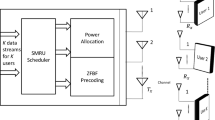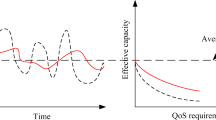Abstract
In many wireless applications, such as video streaming, data transfer or mobile Internet, user satisfaction is directly related to the transmission rates of the wireless channels in the physical layer. If the transmission rate of one user undercuts a certain level, the quality of the application becomes unacceptable. Furthermore network operators are interested in maximizing overall system throughput. However, this aim can usually not be achieved without violating these minimum rate constraints. In this article we therefore consider a practical resource allocation scheme for MIMO OFDM systems that achieves both aims without requiring computationally expensive optimization algorithms. The main part consists of a user classification. Users in one group will only be served with their minimum required rates. The remaining users can exploit the additional system resources more effectively for strong throughput increases and are therefore put in the other group. An iterative application of the proposed scheme enables additional throughput increases and the consideration of maximum transmission rates.
Similar content being viewed by others
References
Cover, T.M., & Thomas, J.A. (1991). Elements of information theory. John Wiley & Sons, Inc.
Foschini J., Gans M.J. (1998). On limits of wireless communications in a fading environment when using multiple antennas. Wireless Personal Communications 6, 311–335
Raleigh G.G., Cioffi J.M. (1998). Spatio-temporal coding for wireless communication. IEEE Transactions on Communications 46, 357–366
Sampath H., Talwar S., Tellado J., Ereceg V., Paulraj A. (2002). A fourth-generation MIMO-OFDM broadband wireless system: Design, performance, and field trial results. IEEE Communications Magazine 40, 143–149
Chung S.-Y., Forney G.D. Jr., Richardson T., Urbanke R. (2001). On the design of low-density parity-check codes within 0.0045 dB of the Shannon limit. IEEE Communication Letters 5, 58–60
Sato H. (1978). An outer bound to the capacity region of broadcast channels. IEEE Transactions on Information Theory 24, 374–377
Yu W. (2006). Sum-capacity computation for the gaussian vector broadcast channel. IEEE Transactions on Information Theory 52, 754–759
Jindal N., Rhee W., Vishwanath S., Jafar S.A., Goldsmith A. (2005). Sum power iterative water-filling for multi-antenna gaussian broadcast channels. IEEE Transactions on Information Theory 51, 1570–1580
Yu W., Rhee W., Boyd S., Cioffi J.M. (2004). Iterative water-filling for gaussian vector multiple access channels. IEEE Transactions on Information Theory 50, 145–151
Costa M. (1983). Writing on dirty paper. IEEE Transactions on Information Theory 29, 439–441
Tejera P., Utschick W., Bauch G., Nossek J.A. (2006). Subchannel allocation in multiuser multiple input multiple output systems. IEEE Transactions on Information Theory 52, 4721–4733
Marler R.T., Arora J.S. (2004). Survey of multi-objective optimization methods for engineering. Structural and Multidisciplinary Optimization 26, 369–395
Weingarten H., Steinberg Y., Shamai S. (2006). The capacity region of the gaussian multiple-input multiple-output broadcast channel. IEEE Transactions on Information Theory 52, 3936–3964
Viswanathan H., Venkatesan S., Huang H. (2003). Downlink capacity evaluation of cellular networks with known interference cancellation. IEEE Journal on Selected Areas in Communications 21, 802–811
Vishwanath S., Jindal N., Goldsmith A. (2003). Duality, achievable rates and sum-rate capacity of gaussian MIMO broadcast channels. IEEE Transactions on Information Theory 49, 2658–2668
Tejera, P., Utschick, W., Bauch, G., & Nossek, J. A. (2006). Efficient implementation of successive encoding schemes for the MIMO OFDM broadcast channel. Paper presented at International Conference on Communications(ICC), Istanbul.
Lee, J., & Jindal, N. (2006). Symmetric capacity of MIMO downlink channels. Paper presented at International Symposium on Information Theory (ISIT), Seattle.
Utschick, W., Tejera, P., Guthy, C., & Bauch, G. (2008). Transmission in OFDM MIMO point to multipoint networks. In C. Sun, J. Chen, & T. Ohira (Eds.), Handbook on advancements in smart antenna technologies for wireless networks. Idea Group.
Jindal N., Goldsmith A. (2003). Capacity and optimal power allocation for fading broadcast channels with minimum rates. IEEE Transactions on Information Theory 49, 2895–2909
Luo J., Lin L., Yates R., Spasojevic P. (2003). Service outage based power and rate allocation. IEEE Transactions on Information Theory 49, 323–330
Michel, T., & Wunder, G. (2007). Achieving QoS and efficiency in the MIMO downlink with limited power. Paper presented at ITG/IEEE workshop on Smart Antennas, Vienna.
Boyd, S., & Vandenberghe, L. (2006). Convex optimization. Cambridge University Press.
Palomar D., Lagunas M., Cioffi J. (2004). Optimum linear joint transmit-receive processing for MIMO channel with QoS constraints. IEEE Transactions on Signal Processing 52, 1179–1197
Bauch, G., Bach Andersen, J., Guthy, C., Herdin, M., Nielsen, J., Tejera, P., Utschick, W., & Nossek, J. A. (2007). Multiuser MIMO channel measurements and performance in a large office environment. Paper presented at IEEE Wireless Communications and Networking Conference (WCNC), Hong Kong.
Author information
Authors and Affiliations
Corresponding author
Rights and permissions
About this article
Cite this article
Guthy, C., Utschick, W., Bauch, G. et al. Sum Throughput Enhancements in Quality of Service Constrained Multiuser MIMO OFDM Systems. Wireless Pers Commun 48, 157–173 (2009). https://doi.org/10.1007/s11277-007-9422-9
Accepted:
Published:
Issue Date:
DOI: https://doi.org/10.1007/s11277-007-9422-9




